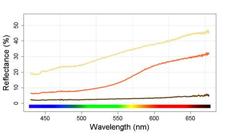ABSTRACT
Several organisms match their skin color to the prevalent background color, granting crypsis against predators. The rate at which body color changes occur varies among organisms as a result of physiological constraints and adaptation to variation in contrasts between objects and the environmental background. Faster darkening of body color is favored in environments that show higher amounts of contrast between common objects and the prevailing background. Soil types in Amazon forest streams (igarapés) create distinct environments with respect to the amount of contrast, a result of the amount of sand and clay, which offers different contrasts against dead leaves. Here, we investigated differences in the rates of color change among populations of the sailfin tetra (Crenuchus spilurus) that represent lineages that live in regions of different soil types. Populations inserted into blackwaters (sandy soil) showed higher rates of color darkening in response to exposure to a dark environment composed by dead leaves. We propose that natural selection stemming from predation can favor faster color change rate in environments where there is higher variability of contrasts between leaf litter and soil, which is common in most blackwater streams.
Keywords:
Background matching; Body color; Crenuchus spilurus; Crypsis; Phenotypic plasticity

 Thumbnail
Thumbnail
 Thumbnail
Thumbnail
 Thumbnail
Thumbnail
 Thumbnail
Thumbnail
 Thumbnail
Thumbnail




